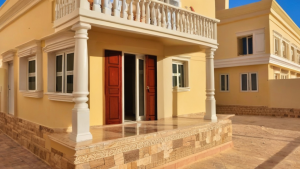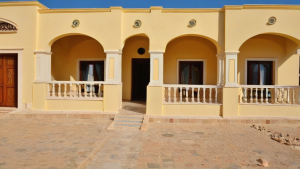Summary about owning and buying property in Hurghada, Egypt.
- Investing in buy-to-let properties can be a rewarding way to generate income and build wealth, but understanding the returns you can realistically expect is crucial before diving in.
- For example, if you pay £200,000 for a property and receive £10,000 per year in rent, your rental yield would be 5%.
- Considering these factors, a gross rental yield of 5% might translate to a net yield of around 3% to 4% after expenses, though this varies widely based on location and property type.
- Over time, most properties tend to increase in value due to factors like market demand, economic growth, and improvements to the property or area.
- Suppose you earn a net rental yield of 4% annually on a £150,000 property, totaling £6,000 per year after costs.
What returns can you expect from a buy-to-let property?
Investing in buy-to-let properties can be a rewarding way to generate income and build wealth, but understanding the returns you can realistically expect is crucial before diving in. The returns from a buy-to-let property typically come in two main forms: rental yield and capital appreciation. Each of these contributes to the potential profitability of your investment, and knowing how they work together helps set realistic expectations.
Rental yield: the income from rent
Rental yield measures the income you earn from rent in relation to the property’s purchase price. It’s one of the most direct ways to assess the immediate cash flow from a buy-to-let investment. Rental yield is generally expressed as a percentage and calculated as follows:
Rental Yield (%) = (Annual Rental Income / Property Purchase Price) × 100
For example, if you pay £200,000 for a property and receive £10,000 per year in rent, your rental yield would be 5%. This figure is an important indicator of how quickly your rental income covers the initial cost of the property.
However, it’s essential to consider other costs that impact your actual returns:
- Mortgage payments: If you’ve leveraged your purchase with a mortgage, the interest and principal repayments reduce your net income.
- Maintenance and repairs: Properties require ongoing upkeep, which can vary based on property age and tenant usage.
- Management fees: If you use a letting agent, management fees typically range from 8% to 15% of rental income.
- Void periods: There may be times when your property is unoccupied, bringing rental income to zero during these stretches.
- Insurance, taxes, and legal fees: Landlord insurance, council tax (if you cover this), and legal compliance costs also affect returns.
Considering these factors, a gross rental yield of 5% might translate to a net yield of around 3% to 4% after expenses, though this varies widely based on location and property type.
Capital appreciation: growth in property value
Besides rental income, buy-to-let investors often rely on property value growth, or capital appreciation, to boost overall returns. Over time, most properties tend to increase in value due to factors like market demand, economic growth, and improvements to the property or area.
Capital appreciation is less predictable than rental income and can be influenced by:
- Local market dynamics such as supply and demand shifts
- Changes in interest rates affecting borrowing costs
- Government policies on property and taxation
- Infrastructure developments enhancing area desirability
- General economic conditions and employment rates
Historic data often shows average annual appreciation rates of around 2% to 5%, but these figures fluctuate significantly. Some regions experience boom periods with double-digit growth, while others might see stagnation or even decline.
Balancing rental income and capital growth
Understanding that rental yield and capital growth contribute differently is important in setting your investment goals. Some investors prioritize high rental income for immediate cash flow, often choosing properties in areas with lower purchase prices but steady rental demand. Others may prefer properties in rapidly growing markets with lower yields but higher capital appreciation potential.
Here’s a simplified illustration of how returns might look over a decade:
- Rental yield: Suppose you earn a net rental yield of 4% annually on a £150,000 property, totaling £6,000 per year after costs.
- Capital growth: If your property appreciates by an average of 3% per year, it would be worth around £201,000 after 10 years.
Your total return would combine the steady rental income received each year plus the eventual uplift in property value when you sell. This combined return often ranges between 7% and 10% per year, depending on market conditions.
Regions and property types influence returns
Where you buy significantly impacts expected returns. For example:
- Urban centers: Larger cities often command higher rents but come with higher purchase prices, potentially pushing rental yields lower but offering stronger capital growth prospects.
- Suburban or regional areas: These locations may offer better yields due to lower property prices and stable rental demand but slower appreciation.
- Student or HMOs (houses in multiple occupation): These property types can generate higher rental income, but might come with increased management complexity and risk.
By researching market trends, rental demand, and local economic indicators, you can better estimate the returns suited to your investment strategy.
Additional factors affecting buy-to-let returns
Several other elements can influence your overall returns:
- Taxation: Changes in tax rules, such as restrictions on mortgage interest relief or increases in capital gains tax, can reduce profitability.
- Inflation: Rising prices can push up rents over time, increasing rental yield, but can also impact mortgage costs.
- Market cycles: Economic downturns or property market corrections may temporarily reduce rental income and property values.
- Management efficiency: Effective property management and tenant selection can lower void periods and maintenance costs, improving net returns.
Being aware of these factors helps you plan a resilient investment capable of weathering changes.
What should you expect?
A prudent investor in buy-to-let properties can often expect net rental yields of around 3% to 5%, combined with potential capital growth of 2% to 5% annually. Together, this typically results in overall returns ranging from 5% to 10% per year, though outcomes vary widely depending on property choice, market conditions, and management.
It’s wise to approach buy-to-let investments with a long-term perspective, understanding both the income and growth components of returns, and factoring in all associated costs and risks. By doing so, you position yourself to make informed decisions that match your financial goals and risk tolerance.
Factors influencing the profitability of buy-to-let investments
Understanding location and market trends
One of the most significant factors that affect the profitability of buy-to-let properties is the location. Properties situated in areas with strong rental demand typically offer better returns. Urban centers, university towns, and places with growing employment opportunities tend to attract more tenants. When evaluating a potential property, look for areas with rising population numbers and infrastructure development, as these often signal future rental growth. Additionally, understanding local market trends such as average rental yields and property price movements can help you identify promising investment hotspots.
Rental yield versus capital growth
Buy-to-let returns come from two main sources: rental income and capital appreciation. The balance between rental yield and capital growth varies depending on the property type and location. Rental yield refers to the income you receive from renting out the property relative to its purchase price, expressed as a percentage. Areas offering high rental yields often have lower purchase prices but might experience slower capital growth. Conversely, properties in prime locations may have lower rental yields but higher potential for price appreciation. To maximize profitability, weigh both these factors carefully to match your investment goals.
Mortgage and financing costs
The cost of financing your buy-to-let investment can significantly affect your net returns. Interest rates on buy-to-let mortgages are often higher than on residential loans, and lenders usually require a larger deposit, sometimes around 25% or more. It’s essential to factor in mortgage interest payments, arrangement fees, and other borrowing costs. If you’re using a mortgage, calculating the rental income against your monthly mortgage payments will help you understand if the property is cash flow positive or negative. A positive cash flow means rental income covers all expenses, enhancing your profitability.
Operational expenses and maintenance
Owning a buy-to-let property also involves ongoing costs beyond the mortgage. These include:
- Property management fees, if you choose to hire an agent
- Routine maintenance and repairs
- Insurance premiums
- Landlord licensing and safety certificates
- Void periods, times when the property is unoccupied and not generating rental income
Keeping these expenses in check is crucial for maintaining healthy returns. Budgeting for unexpected repairs and periods without tenants can protect your investment from sudden financial strain.
Taxation impact on net returns
Tax policies surrounding rental income and capital gains can heavily influence your actual profitability. Rental income is subject to income tax, and buy-to-let investors must also consider capital gains tax (CGT) when selling the property. Recent tax changes, such as restrictions on mortgage interest relief, have made this sector more challenging. Self-employed landlords or limited company structures might offer alternative tax strategies, but it’s wise to consult a tax professional. Understanding how different taxes affect your investment ensures you are not caught off guard by unexpected liabilities.
Tenant profile and demand stability
The type of tenants your property attracts can shape your income reliability. Properties near universities often have student tenants who might cause higher wear and tear but typically guarantee steady occupancy during term times. Meanwhile, family homes in suburban areas may attract longer-term tenants with fewer vacancies but potentially slower rental increases. Researching local demographics and tenant demand will help you align your property choice with secure rental income streams.
Property condition and renovation potential
The initial state of the buy-to-let property can affect both upfront costs and long-term returns. Older properties might require significant refurbishment, which adds to your investment but can increase rental value and attract better tenants. Conversely, newer builds may command higher rents from the start but often come with higher purchase prices and management fees. Assessing the potential to enhance the property through renovations or improvements can improve yield and capital growth prospects.
Legal and regulatory environment
Changes in regulations can quickly alter the financial dynamics of buy-to-let investments. Recent shifts in landlord licensing, deposit protection schemes, and energy efficiency standards require landlords to stay informed and compliant. Failing to meet evolving legal obligations can result in fines or legal disputes, reducing profitability. Staying updated with local tenancy laws ensures that your investment remains secure and returns consistent.
Economic factors affecting buy-to-let returns
Broader economic conditions also play a role in shaping rental property returns. Inflation, interest rates, and employment rates influence tenants’ ability to pay rent and property values. For example, rising interest rates may increase mortgage costs, squeezing investor margins. Conversely, a strong job market can boost demand for rental properties. Understanding these macroeconomic influences allows you to anticipate challenges and adapt your investment strategy.
Key takeaways for maximizing buy-to-let profitability
- Choose locations with strong rental demand and growth potential
- Balance rental yield with capital appreciation based on your investment objectives
- Account for mortgage costs and aim for positive cash flow
- Factor in operational expenses and prepare for vacancies
- Keep abreast of taxation rules to optimize net returns
- Understand tenant demographics to minimize risk
- Consider property condition and renovation impact on value
- Stay compliant with legal regulations to avoid penalties
- Monitor economic trends to make informed investment decisions
Understanding the returns you can expect from a buy-to-let property is essential before stepping into this type of investment. While rental yields offer a clear picture of the income potential, the actual profitability depends on a range of factors. Location plays a crucial role, as properties in high-demand areas tend to attract reliable tenants and command better rents. Additionally, upfront costs like purchase price, mortgage rates, and ongoing expenses such as maintenance and property management fees all impact your net returns.
The market conditions and local rental demand fluctuate over time, influencing both rental income and property value appreciation. Being aware of these variables helps you make smarter decisions about where and when to buy. Also, tax implications and regulatory changes may affect the overall profitability, so staying informed is vital to protect your returns.
Ultimately, the returns from a buy-to-let property vary widely depending on how well you manage these factors. By carefully researching property locations, calculating all costs, and keeping an eye on market trends, you can improve your chances of securing a steady income and long-term growth. Remember, a successful buy-to-let investment isn’t just about the initial purchase price but about the full picture of income, expenses, and property appreciation over time. With the right approach, buy-to-let can be a rewarding way to build wealth while generating passive income.










